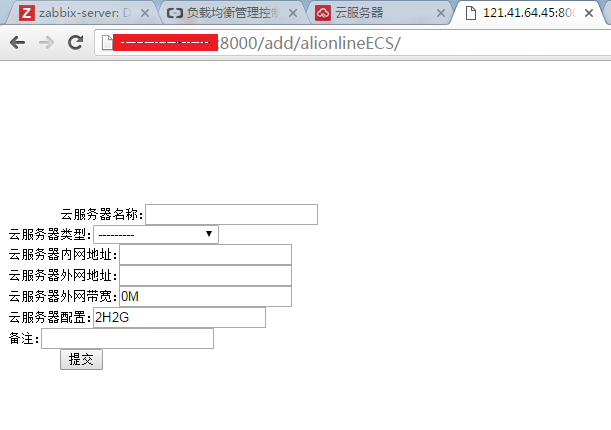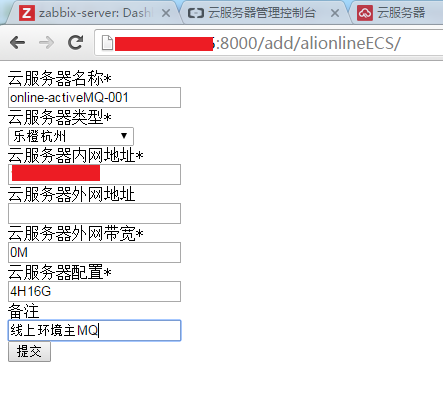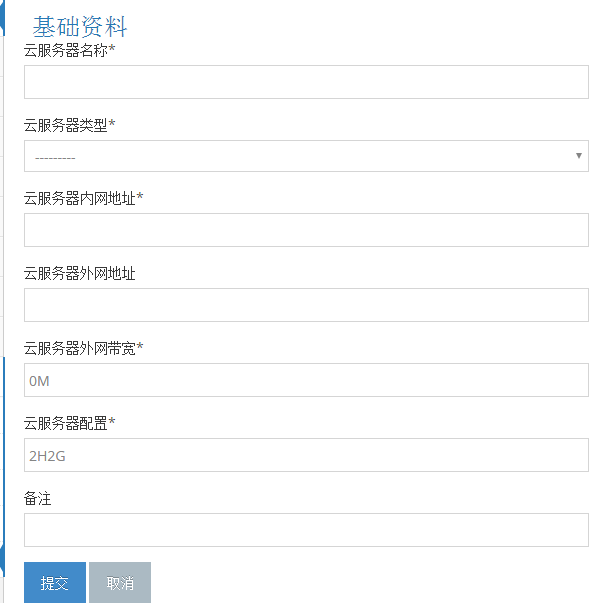Django運維後臺的搭建之五:引入databases和django-crispy-forms
在上一篇,我們已經把我們做的運維外面套上了bootstrap框架,但是那僅僅是一個外殼,這一次是要把裏面的壤也扣上這樣的框架。
首先,編輯index.html,添加block元素,用於主頁存放不同的內容:
<div class="page-content">
<div class="page-content-area">
<div class="page-header">
<h1>
<!--設置導航欄的頁面標題-->
{% block page_title %}
{% endblock %}
<small>
<i class="ace-icon fa fa-angle-double-right"></i>
<!--設置導航欄的頁面子標題-->
{{ sub_title }}
</small>
</h1>
</div><!-- /.page-header -->
<div class="row">
<div class="col-xs-12">
<!-- PAGE CONTENT BEGINS -->
<!--設置頁面內容-->
{% block container %}
{% endblock %}
<!-- PAGE CONTENT ENDS -->
</div><!-- /.col -->
</div><!-- /.row -->
</div><!-- /.page-content-area -->
</div><!-- /.page-content -->之前在models.py裏我們設定了很多個項目,比如alionlineECS,alifuncECS等等,那麽對應每一個項目都會有一個html,在這裏我命名:alionlineECS_list.html用於存放“阿裏雲線上環境服務器”信息,alifuncECS_list.html用於“阿裏雲測試環境服務器”信息,ksonlineECS_list.html用於存放“金山雲線上環境服務器”信息,ksfuncECS_list.html用於“金山雲測試環境服務器”信息,同時修改index.html中Table下的鏈接,將其中的鏈接指向上面那些html們:
<ul class="submenu">
<li class="">
<a href="{% url ‘lists‘ table=‘alionlineECS‘ %}">
<i class="menu-icon fa fa-caret-right"></i>
阿裏雲線上環境服務器
</a>
<b class="arrow"></b>
</li>
<li class="">
<a href="{% url ‘lists‘ table=‘alifuncECS‘ %}">
<i class="menu-icon fa fa-caret-right"></i>
阿裏雲測試環境服務器
</a>
<b class="arrow"></b>
</li>
<li class="">
<a href="{% url ‘lists‘ table=‘ksonlineECS‘ %}">
<i class="menu-icon fa fa-caret-right"></i>
金山雲線上環境服務器
</a>
<b class="arrow"></b>
<li class="">
<a href="{% url ‘lists‘ table=‘ksfuncECS‘ %}">
<i class="menu-icon fa fa-caret-right"></i>
金山雲測試環境服務器
</a>
<b class="arrow"></b>
</li>
</ul>建立res_list.html放在之前的template文件夾裏,用來存放資源類表格,並把它作為一個模板,供其他頁面繼承,這樣可以節省大量的重復代碼。
<!--繼承index.html-->
{% extends "index.html" %}
{% block page_css %}
{% endblock %}
<!--填充導航欄的頁面名稱-->
{% block page_title %}
基礎資料
{% endblock %}
<!--放置主頁面內容-->
{% block container %}
{% load staticfiles %}
<div class="row">
<!-- Search Page BEGINS-->
<div class="col-xs-12">
<form class="navbar-for navbar-container" role="search" method="get" action="">{% csrf_token %}
<!--放置搜索欄內容-->
{% block search %}
{% endblock %}
<div class="col-sm-3">
<span class="input-group-btn">
<button type="submit" class="btn btn-purple btn-sm">
查詢
<i class="ace-icon fa fa-search icon-on-right bigger-110"></i>
</button>
</span>
</div>
</form>
</div>
<!-- Search Page END -->
<!-- PAGE TABLES BEGINS -->
<div class="col-xs-12">
<div>
<table id="table_id" class="table table-striped table-bordered table-hover">
<thead>
<!--表格頭部-->
{% block table_tr %}
{% endblock %}
<th>
<!--最後一列作為添加數據按鈕-->
<a class="blue" href="{% url ‘add‘ table=table %}">
<i class="ace-icon fa fa-search-plus bigger-130"></i>
添加數據
</a>
</th>
</thead>
<!--表格內容-->
<tbody>
{% for item in data %}
<tr>
<!--通過for循環從data取出的具體表格內容-->
{% block table_td %}
{% endblock %}
<td>
<!--頁面擴展時的按鈕布局-->
<div class="hidden-sm hidden-xs action-buttons">
<!--編輯信息按鈕-->
<a class="green" href="{% url ‘edit‘ table item.id %}" title="編輯信息">
<i class="ace-icon fa fa-pencil bigger-130"></i>
</a>
<!--刪除信息按鈕-->
<a class="red" href="{% url ‘delete‘ table item.id %}" title="刪除信息">
<i class="ace-icon fa fa-trash-o bigger-130"></i>
</a>
</div>
<!--頁面收縮時的按鈕布局-->
<div class="hidden-md hidden-lg">
<div class="inline position-relative">
<button class="btn btn-minier btn-yellow dropdown-toggle" data-toggle="dropdown"
data-position="auto">
<i class="ace-icon fa fa-caret-down icon-only bigger-120"></i>
</button>
<ul class="dropdown-menu dropdown-only-icon dropdown-yellow dropdown-menu-right dropdown-caret dropdown-close">
<li>
<a href="{% url ‘add‘ table=table %}" class="tooltip-info" data-rel="tooltip" title="添加數據">
<span class="blue">
<i class="ace-icon fa fa-search-plus bigger-120"></i>
</span>
</a>
</li>
<li>
<a href="{% url ‘edit‘ table item.id %}" class="tooltip-success" data-rel="tooltip" title="修改信息">
<span class="green">
<i class="ace-icon fa fa-pencil-square-o bigger-120"></i>
</span>
</a>
</li>
<li>
<a href="{% url ‘delete‘ table item.id %}" class="tooltip-error" data-rel="tooltip" title="刪除信息">
<span class="red">
<i class="ace-icon fa fa-trash-o bigger-120"></i>
</span>
</a>
</li>
</ul>
</div>
</div>
</td>
</tr>
{% endfor %}
</tbody>
</table>
</div>
</div>
</div>
{% endblock %}
{% block page_javascript %}
<!--datatable的專用js-->
<script type="text/javascript">
$(document).ready(function () {
$(‘#table_id‘).DataTable({
//分頁配置
"paging": false,
//搜索配置
"searching": false,
"bInfo": false,
//列配置
"columnDefs": [{
//只有最後一行不需要排序
"orderable": false, "targets": -1
}]
});
});
</script>
{% endblock %}alionlineECS_list.html,alifuncECS_list.html,slb_list.html等html文件繼承res_list.html,並將各自不一樣的內容在相應的block中進行填充,比如alionlineECS_list.html就是下面的樣子:
{% extends "res_list.html" %}
{% block search %}
{% endblock %}
{% block table_tr %}
<th>雲服務器名稱</th>
<th>雲服務器類型</th>
<th>雲服務器內網地址</th>
<th>雲服務器外網地址</th>
<th>雲服務器外網帶寬</th>
<th>雲服務器配置</th>
<th>備註</th>
<th>登記人</th>
{% endblock %}
{% block table_td %}
<td>{{ item.ecs_name }}</td>
<td>{{ item.ecs_type }}</td>
<td>{{ item.ecs_inip }}</td>
<td>{{ item.ecs_outip }}</td>
<td>{{ item.ecs_ipwidth }}</td>
<td>{{ item.ecs_spec }}</td>
<td>{{ item.ecs_remarks }}</td>
<td>{{ item.ecs_signer }}</td>
{% endblock %}而slb_list.html就是這樣:
{% extends "res_list.html" %}
{% block search %}
{% endblock %}
{% block table_tr %}
<th>負載均衡名稱</th>
<th>網絡類型</th>
<th>轉發規則</th>
<th>ip地址</th>
<th>負載均衡協議</th>
<th>前端端口</th>
<th>後端端口</th>
<th>負載均衡協議</th>
<th>前端端口</th>
<th>後端端口</th>
<th>登記人</th>
<th>備註</th>
{% endblock %}
{% block table_td %}
<td>{{ item.slb_name }}</td>
<td>{{ item.slb_type }}</td>
<td>{{ item.slb_algorithm }}</td>
<td>{{ item.slb_ip }}</td>
<td>{{ item.slb_protocol }}</td>
<td>{{ item.slb_fport }}</td>
<td>{{ item.slb_bport }}</td>
<td>{{ item.slb_protocol2 }}</td>
<td>{{ item.slb_fport2 }}</td>
<td>{{ item.slb_bport2 }}</td>
<td>{{ item.slb_signer }}</td>
<td>{{ item.slb_remarks }}</td>
{% endblock %}rds_list.html的代碼如下:
{% extends "res_list.html" %}
{% block search %}
{% endblock %}
{% block table_tr %}
<th>數據庫名稱</th>
<th>數據庫類型</th>
<th>mysql版本</th>
<th>數據庫規格</th>
<th>備註</th>
<th>數據庫地址</th>
<th>存儲空間</th>
<th>登記人</th>
{% endblock %}
{% block table_td %}
<td>{{ item.rds_name }}</td>
<td>{{ item.rds_type }}</td>
<td>{{ item.rds_mysql }}</td>
<td>{{ item.rds_spec }}</td>
<td>{{ item.rds_remark }}</td>
<td>{{ item.rds_ip }}</td>
<td>{{ item.rds_status }}</td>
<td>{{ item.rds_signer }}</td>
{% endblock %}網頁代碼都準備好了,再往下的內容是修改views.py,把lists那個函數改成這樣:
def lists(request,table):
#不同的需求跳到不同的界面
if table == ‘alionlineECS‘:
data = alionlineECS.objects.all()
list_template = ‘alionlineECS_list.html‘
sub_title = ‘阿裏雲線上環境服務器‘
if table == ‘alifuncECS‘:
data = alifuncECS.objects.all()
list_template = ‘alifuncECS_list.html‘
sub_title = ‘阿裏雲測試環境服務器‘
if table == ‘ksonlineECS‘:
data = ksonlineECS.objects.all()
list_template = ‘ksonlineECS_list.html‘
sub_title = ‘金山雲線上環境服務器‘
if table == ‘ksfuncECS‘:
data = ksfuncECS.objects.all()
list_template = ‘ksfuncECS_list.html‘
sub_title = ‘金山雲線上環境服務器‘
if table == ‘SLB‘:
data = SLB.objects.all()
list_template = ‘slb_list.html‘
sub_title = ‘負載均衡‘
if table == ‘RDS‘:
data = RDS.objects.all()
list_template = ‘rds_list.html‘
sub_title = ‘數據庫‘
#建立一個context,將值傳遞到對應的頁面
context = {
‘data‘: data,
‘table‘: table,
‘sub_title‘: sub_title,
}
#跳轉到相應頁面,並將具體的值傳遞過去
return render(request,list_template,context)add的函數應該是這樣:
def add(request,table):
#根據提交的請求不同,獲取來自不同Form的表單數據
if table == ‘alionlineECS‘:
form = alionlineForm(request.POST or None)
if table == ‘alifuncECS‘:
form = alifuncForm(request.POST or None)
if table == ‘ksonlineECS‘:
form = ksonlineForm(request.POST or None)
if table == ‘ksfuncECS‘:
form = ksfuncForm(request.POST or None)
if table == ‘SLB‘:
form = SLBForm(request.POST or None)
if table == ‘RDS‘:
form = RDSForm(request.POST or None)
#判斷form是否有效
if form.is_valid():
#創建實例,需要做些數據處理,暫不做保存
instance = form.save(commit=False)
#將登錄用戶作為登記人
if table == ‘alionlineECS‘:
instance.ecs_signer = request.user
if table == ‘alifuncECS‘:
instance.ecs_signer = request.user
if table == ‘ksonlineECS‘:
instance.ecs_signer = request.user
if table == ‘ksfuncECS‘:
instance.ecs_signer = request.user
if table == ‘SLB‘:
instance.slb_signer = request.user
if table == ‘RDS‘:
instance.rds_signer = request.user
#保存該實例
instance.save()
#跳轉至列表頁面
return redirect(‘lists‘,table=table)
#創建context來集中處理需要傳遞到頁面的數據
context = {
‘form‘: form,
‘table‘: table,
}
#如果沒有有效提交,則仍留在原來頁面
return render(request,‘add.html‘,context)同時,我們要添加兩個新的函數,一個叫edit,他的內容如下:
#修改數據,函數中的pk代表數據的id
def edit(request,table,pk):
if table == ‘alionlineECS‘:
#這是Django的一個快捷方法,通過pk去line表中取值,如果有值則返回,如果無值則拋出http404的異常
#具體信息可參考https://docs.djangoproject.com/en/1.9/topics/http/shortcuts/
table_ins = get_object_or_404(alionlineECS,pk=pk)
#通過instance來將Form的數據做填充
form = alionlineForm(request.POST or None,instance=table_ins)
sub_title = ‘修改阿裏雲線上環境信息‘
if table == ‘alifuncECS‘:
table_ins = get_object_or_404(alifuncECS,pk=pk)
form = alifuncForm(request.POST or None,instance=table_ins)
sub_title = ‘修改阿裏雲線上環境信息‘
if table == ‘ksonlineECS‘:
table_ins = get_object_or_404(ksonlineECS,pk=pk)
form = ksonlineForm(request.POST or None,instance=table_ins)
sub_title = ‘修改金山雲線上環境服務器信息‘
if table == ‘ksfuncECS‘:
table_ins = get_object_or_404(ksfuncECS,pk=pk)
form = ksfuncForm(request.POST or None,instance=table_ins)
sub_title = ‘修改金山雲測試環境服務器信息‘
if table == ‘SLB‘:
table_ins = get_object_or_404(SLB,pk=pk)
form = SLBForm(request.POST or None,instance=table_ins)
sub_title = ‘修改負載均衡信息‘
if table == ‘RDS‘:
table_ins = get_object_or_404(RDS,pk=pk)
form = RDSForm(request.POST or None,instance=table_ins)
sub_title = ‘修改數據庫信息‘
#判斷form是否有效
if form.is_valid():
#創建實例,需要做些數據處理,暫不做保存
instance = form.save(commit=False)
#將登錄用戶作為登記人,在修改時,一定要使用str強制
if table == ‘alionlineECS‘:
instance.ecs_signer = str(request.user)
if table == ‘alifuncECS‘:
instance.ecs_signer = str(request.user)
if table == ‘ksonlineECS‘:
instance.ecs_signer = str(request.user)
if table == ‘ksfuncECS‘:
instance.ecs_signer = str(request.user)
if table == ‘SLB‘:
instance.slb_signer = str(request.user)
if table == ‘RDS‘:
instance.rds_signer = str(request.user)
#保存該實例
instance.save()
#跳轉至列表頁面,配合table參數,進行URL的反向解析
return redirect(‘lists‘, table=table)
context = {
‘table‘: table,
‘form‘: form,
‘page_title‘: ‘基礎資料‘,
‘sub_title‘: sub_title,
}
#與res_add.html用同一個頁面,只是edit會在res_add頁面做數據填充
return render(request,‘res_add.html‘,context)另一個函數是delete,這個是用來刪除的,內容如下:
#刪除操作
def delete(request,table,pk):
#選擇相應的表格
if table == ‘alionlineECS‘:
#通過id值獲取相應表格的實例,有值則返回,無值則拋出異常
table_ins = get_object_or_404(alionlineECS,pk=pk)
if table == ‘alifuncECS‘:
table_ins = get_object_or_404(alifuncECS,pk=pk)
if table == ‘ksonlineECS‘:
table_ins = get_object_or_404(ksonlineECS,pk=pk)
if table == ‘ksfuncECS‘:
table_ins = get_object_or_404(ksfuncECS,pk=pk)
if table == ‘SLB‘:
table_ins = get_object_or_404(SLB,pk=pk)
if table == ‘RDS‘:
table_ins = get_object_or_404(RDS,pk=pk)
#接收通過AJAX提交過來的POST
if request.method == ‘POST‘:
#刪除該條目
try:
table_ins.delete()
#刪除成功,則data信息為success
data = ‘success‘
except IntegrityError:
#如因外鍵問題,或其他問題,刪除失敗,則報error
data = ‘error‘
#將最後的data值傳遞至JS頁面,進行後續處理,safe是將對象序列化,否則會報TypeError錯誤
return JsonResponse(data,safe=False)別忘了這裏還要修改一下主urls.py,添加edit和delete:
from django.conf.urls import url,include
from django.contrib import admin
import Online.views
admin.autodiscover()
from Online import views as Online_views
urlpatterns = [
url(r‘^admin/‘,admin.site.urls),
url(r‘^lists/(?P<table>\w+)/$‘,Online.views.lists,name=‘lists‘),
url(r‘^add/(?P<table>\w+)/$‘,Online.views.add,name=‘add‘),
#基礎資料的顯示
#修改數據,?P<pk>\d+代表穿過來的id值,且id值一定為數字
url(r‘^edit/(?P<table>\w+)/(?P<id>\d+)/$‘,Online.views.edit,name=‘edit‘),
#刪除數據
url(r‘^delete/(?P<table>\w+)/(?P<pk>\d+)/$‘,Online.views.delete,name=‘delete‘),
url(r‘^index/‘,Online.views.index,name=‘index‘),
url(r‘^login/‘,include(‘Online.urls‘)),
]啟動django,在瀏覽器裏輸入"外網地址:8000/lists/slb"就發現原來那個白色的界面已經運用了boostrap模板,如下:

而打開"外網地址:8000/lists/alionlineECS",對應阿裏區線上環境的資料也是套用了boostrap模板:

當你點擊“添加數據”的時候,界面也是會正確轉向的:

但是這個增加的頁面很難看,白白的底兒,很挫,我們也希望這個增加的界面也有模板的樣子。於是這裏要用一個django-crispy-forms的app,首先在服務器裏,使用#pip install --upgrade django-crispy-forms下載並安裝。
然後在settings.py中加入相關app,並使其使用bootstrap3的前端。修改settings.py如下:
INSTALLED_APPS = [
‘django.contrib.admin‘,
‘django.contrib.auth‘,
‘django.contrib.contenttypes‘,
‘django.contrib.sessions‘,
‘django.contrib.messages‘,
‘django.contrib.staticfiles‘,
‘Online‘,
‘SLB‘,
‘RDS‘,
#crispy app 把這個APP添加進去
‘crispy_forms‘,
]
然後還要在settings.py後面追加下面一句話:
#App settings CRISPY_TEMPLATE_PACK = ‘bootstrap3‘
再修改add.html文件,把crispy.form應用進去:
<!--引用crispy-forms標簽-->
{% load crispy_forms_tags %}
<!DOCTYPE html>
<html>
<head lang="en">
<meta charset="UTF-8">
<title></title>
</head>
<body>
<form method=‘POST‘ action=‘‘>{% csrf_token %}
<!--將crispy-forms應用到form中-->
{{ form | crispy }}
<input type=‘submit‘ value=‘提交‘ />
</form>
</body>
</html>然後再返回來看看添加的界面,嗯,好像變樣了:

我們現在為了統一,把add.html改成res_add.html,同時繼承index.html,將res_add.html中的內容填充到index的Container block。
{% extends "index.html" %}
<!--引用crispy-forms標簽-->
{% load crispy_forms_tags %}
{% block page_title %}
基礎資料
{% endblock %}
{% block container %}
<div class="row">
<div class="col-sm-3 pull-left">
<form method=‘POST‘ action=‘‘>{% csrf_token %}
<!--將crispy-forms應用到form中-->
{{ form | crispy}}
<input class=‘btn btn-primary‘ type=‘submit‘ value=‘提交‘ />
<a href="{% url ‘lists‘ table=table %} "><input class=‘btn btn-default‘ type=‘button‘ value=‘取消‘ /></a>
</form>
</div>
</div>
{% endblock %}然後再把views.py裏面add函數裏面最後那一行
return render(request,‘add.html‘,context)
改成
return render(request,‘res_add.html‘,context)
至此,整個添加界面就全部繼承過來了:

本文出自 “生活就是等待戈多” 博客,請務必保留此出處http://chenx1242.blog.51cto.com/10430133/1952685
Django運維後臺的搭建之五:引入databases和django-crispy-forms
